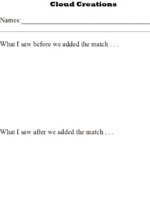Cloud Creations
| Instant wiki maker | Making handouts | Editing tips |
Contents
- 1 Cloud Creations
- 1.1 Student worthiness
- 1.2 Primary biological content area covered
- 1.3 Materials
- 1.4 Safety Section
- 1.5 Handouts
- 1.6 Description of activity
- 1.7 Lesson plan
- 1.8 Potential pitfalls
- 1.9 Art Connections
- 1.10 Literature connections
- 1.11 Connections to educational standards
- 1.12 Next steps
- 1.13 Reflection
- 1.14 Citations and links
Biology In Elementary Schools is a Saint Michael's College student project from a course that ran between 2007 and 2010 and fully described in this book chapter. The student-created resources have been preserved here for posterity. Link under 'toolbox' for printer-friendly versions of the exercises. Click on handouts to print full resolution versions. Please see Wikieducator's disclaimer, our safety statement, and the Creative Commons licensing in English and in legalese.
Cloud Creations
Student worthiness
This is a borrowed experiement. Tried and Trusted.
Primary biological content area covered
- Evaporation
- Cloud Formations
Materials
- 2-liter plastic soda bottle
- Matches (Children will need adult assistance)
- Warm water
Safety Section
- This experiement involves matches that students should not handle.
- The teacher should explain the dangers of fire and that this is not an experiement for them to try at home without parental guidance.
Handouts
Description of activity
This activity will allow students to create their own cloud. They will also learn different aspects of the water cycle and how a cloud is actually created in the atmosphere.
Lesson plan
- Have the students fill the bottle half of the way with warm water and place the cap on top.
- Have the students squeeze the bottle and record what happens when they release it (Note: If the inside of the bottle is covered by condensation just shake it to get rid of the water droplets).
- Next, light a match and hold it over the now opened bottle.
- Drop the match into the water and quickly place the cap back on the bottle to create the second part of the cloud (smoke or dust particles).
- Then have the students squeeze the bottle once again. A cloud should appear!
- Have students record their observations with a drawing.
<kaltura-widget kalturaid='302289' size='L' align='R'/>
Potential pitfalls
- Too much time can elapse in the middle part of the experiment with placing the cap back on the bottle.
- The water must be at a proper temperature (warm) for the students to handle.
- Students may be attracted to the fire of matches and harm themselves.
- Clouds may not form if directions are not followed carefully.
Art Connections
- Students can draw their different observations on the handout as the experiment is in progress.
Literature connections
- Cloudy with a Chance of Meatballs. By Judi Barrett and Ron Barrett, Aladdin (1982)
- The Magic School Bus Kicks Up A Storm: A Book About Weather . By Nancy White, Scholastic Paperbacks (2000)
- The Magic School Bus At the Waterworks. By Joanna Cole, Scholastic Press (1988)
Connections to educational standards
- 7.15 The universe, earth, and the enviornment: theories, systems, and forces cc: identify, record, model, and explain the interrelated parts and connections between earth systems.
- 7.15 The universe, earth, and the enviornment: theories, systems, and forces bb: identify evidence of, model, and explain the patterns and focres that shape the earth.
Next steps
- Students can measure the temperature of the water in the bottle. If there is extra time, have them make an experiment that compares the results between cold and hot water.
Reflection
We believe that this experiment was successful. At the beginning of the experiment the student's enjoyed reading the books about clouds. The books made them more excited to see the cloud experiment. Even though the student's were not able to take part in the section of the experiment with the matches they were excited to watch. Although the experiment can be done without food coloring the students found it exciting to shake the bottle to mix the food coloring. I also felt that this experiment was a success because it encouraged students to think about what really occurs in the process of evaporation and how water is processed itself. We may not have gone into great detail about the vocabulary, but we still addressed the important aspects and introduced the students to the water cycle in a fun and engaging way.
Citations and links
http://www.weatherwizkids.com/cloud1.htm Weather Wiz Kids

